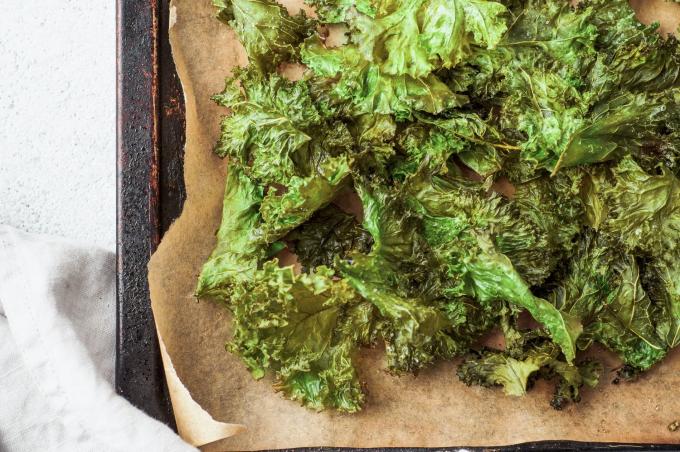Kale stays in the garden until winter. But the season ends faster than expected. Here you will find everything you need to know about harvesting and freezing kale.

For many, kale is just as much a part of winter as icy temperatures. But even beyond the cold season, kale is a delicious and very healthy leafy vegetable. We tell you when you should bring in your own harvest and how you can preserve your kale.
contents
- Harvesting kale: the right time
-
Storing and preserving kale
- Freeze kale
- Drying kale: make kale chips yourself
- Boil kale
Harvesting kale: the right time
Kale is a typical winter vegetable. Harvest time begins in late November and can take place over several months. The length of the harvesting period depends on how hardy your plants are Kale variety is. It is generally said that kale should be exposed to a severe frost before it is harvested - only then will it develop its full flavor. Since there is no hard and fast rule when it comes to harvesting kale, you should grow your own kale Harvest at different times of the winter and find out for yourself when it suits you best tastes.

Storing and preserving kale
Kale is a nutritious and protein-rich meal for lovers all year round, which can be used in many different ways. The options for preserving kale are just as varied as the recipe ideas.

Freeze kale
If you want to keep your beloved kale for a long time, you should store it in the freezer. Before you refrigerate it, however, there are a few things to consider.
- Wash the kale well to remove any dirt and sand
- Remove leaves from the main stem
- Blanch kale: Place in boiling salted water for 2-3 minutes
- Rinse the kale with cold water
- Drain well and chop to desired size
- Place kale in jars: Ready to freeze!
Drying kale: make kale chips yourself
Another way to give the frost-loving winter vegetables a longer shelf life is to dehydrate kale. To do this, separate the leaves from the main stem, wash them and then chop them into bite-sized pieces. You can now give the kale a rather simple flavor with a little oil, salt and pepper or opt for a more unusual variant. There are many recipes in which the kale chips are tossed with some hazelnut or almond paste to create a delicious and crunchy crust. Sesame paste, chia seeds or even oatmeal are also used in some recipes.

It is particularly important that all other ingredients (apart from the kale) are processed into a marinade so that the kale is evenly coated later. This guarantees a crispy, crispy crust. Once you have mixed all the ingredients with the kale, spread the mixture on a baking sheet. Now it's time for the actual drying process. When drying kale, the chips should dry at 40 to 50 °C for about 6 to 8 hours. You can use a standard oven for this, or a special dehydrator. After half a day of patience, you can finally enjoy your delicious and homemade kale chips!
Boil kale
Probably the most classic way to preserve kale is to boil it down. To do this, proceed as follows:
- Wash kale: Remove dirt and sand residue
- Cook kale: Place in boiling salted water for 6-8 minutes
- Chopping and Portioning Kale: Chop your kale to desired size and place in mason jars
- Pour salted water over kale and seal jars
- Boil closed jars in boiling water for another 20 minutes
Notice: Unfortunately, when boiling the kale, it cannot be prevented that valuable nutrients are lost!
More information about Kale can be found in our review article. We will introduce you to different types of kale and explain what needs to be considered when growing and caring for the kale.



